Formula templates enable you to build a single template for a formula that you can reuse with different connectors and values. After you build a formula template, you can then create a formula instance where you replace the variables with actual instances and values. This approach helps you build efficient and reusable formulas.
Build a Formula Template
Formula templates include a trigger that kicks off the formula, steps that execute as a result of the trigger, and variables to represent input required to run an instance of the formula. You can build formulas that use triggers that kick off when something happens to a connector instance, you can schedule triggers, or you can manually kick off a trigger. See Formula Triggers for more information about each kind of trigger.
As you build a formula, you also build context consisting of triggers, variables, steps, and values created by steps. You can refer to that context in later steps in the formula. Consider each part as a building block that has a name and information that you can refer to. For example, in a formula that sends an email notification for a new contact, you build the body of the email in one step. In a later step when you actually send the message, refer to the step where you built the body.
Create a Formula Template in the UI
- Open the Formulas page.
- Click Build New Formula Template.
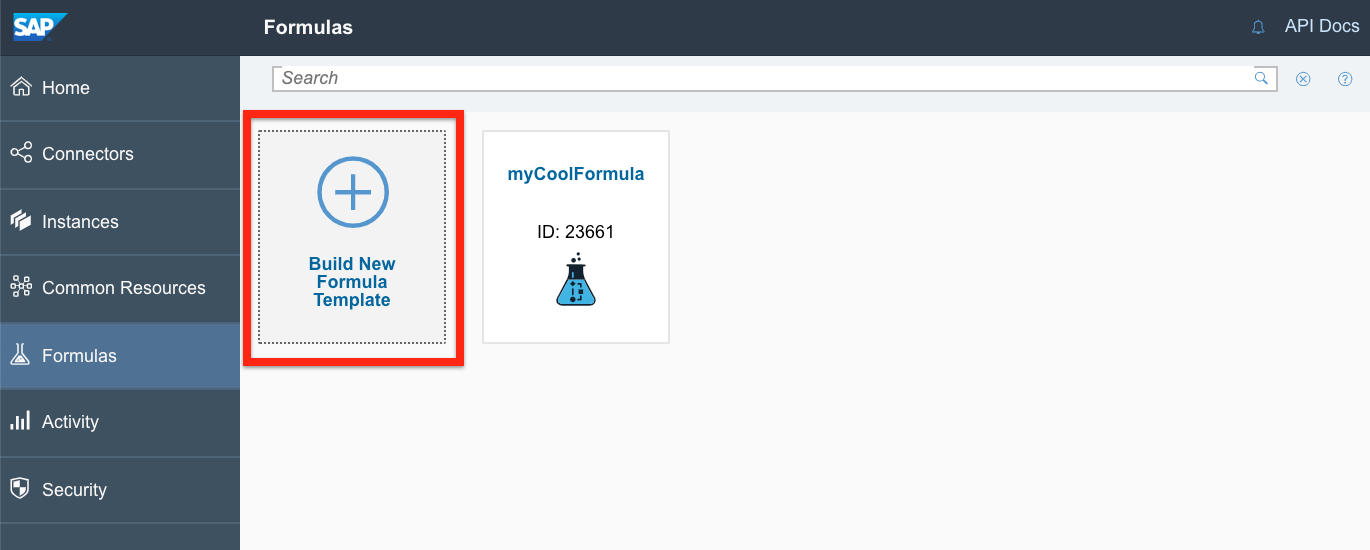
- Click Build New Formula.
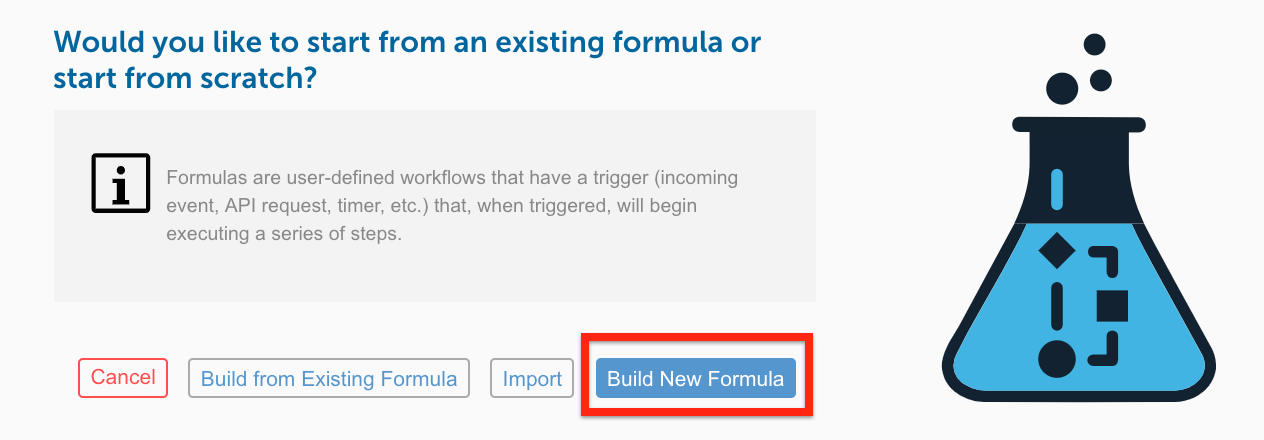
- Enter a name for your formula, and then click Create.
SAP Open Connectors provides you a list of triggers. For details about each trigger, see Formula Triggers.

Select your trigger.
Note: Deleting a trigger removes its steps from the canvas. After deleting a trigger, you will be prompted to pick a new trigger, at which point you can add back the steps by selecting them from the Add From Existing section.- Choose Event for a formula triggered by an event configured on a connector instance.
- Choose Connector Request for a formula triggered when a specific request is made to a connector instance.
- Choose Scheduled for a formula to occur at a specific time or regular interval.
- Chose Manual to trigger the formula with an API call to
POST /formulas/instances/:id/executions.
- Complete the trigger properties, which vary based on the selected trigger.
- For Event provide a Connector Instance Variable.
- For Formula Request provide a Connector Instance Variable, an API method, and API endpoint.
- For Scheduled provide a Cron schedule.
- For Manual you do not need to provide any more properties.
- Click Save.
SAP Open Connectors shows the first trigger node in the formula visualization.

- Add any variables that you will need to run the formula instance.
- Click Variables.

- Select the type of variable, and then enter a name.
Takes note of the Formula Step Variable Name, which is how you will refer to the variable throughout the formula.
- Click Save.
- Click Variables.
Add your first step. In the formula visualization, click
 .
.Select the type of step that you want to add.
Complete the step properties, and then click Save. For details on each step, see a Connector Instance Variable.
Note: Click Add From Existing to find a step to copy.SAP Open Connectors shows the first trigger node and the step that you just created in the formula visualization. The path from the trigger to the step defaults to On Success, but you can add failure steps later.

To add another step, click the step, and then select one of the following:
- Insert Above adds a new step prior to the current step with an On Success path connecting the two.
- Add On Success adds a step for the formula to continue to if the current step succeeds.
- Add On Failure adds a step for the formula to continue to if the current step fails.
Continue adding steps until you complete the formula template.
Add a description by clicking Edit. See Add a Description to a Formula Template.
After you complete the formula, test it.
Build a Formula Template via API
You can build a formula with an API request to the POST /formulas endpoint. Your formula JSON includes the triggers, steps and variables that make up your formula. The configuration object contains your variables, while the triggers and steps objects contain their relevant information. See the sample file below:
{
"name":"Formula Name",
"description":"Formula Description.",
"configuration":[
{
"name":"instanceName",
"type":"elementInstance",
"key":"instanceName"
},
{
"name":"instanceName2",
"type":"elementInstance",
"key":"instanceName2"
} {
"name":"valueName",
"type":"value",
"key":"valueName"
}
],
"triggers":[
{
"type":"event",
"properties":{
"elementInstanceId":"${instanceName}"
},
"onSuccess":[
"step1"
]
}
],
"steps":[
{
"name":"step1",
"type":"filter",
"properties":{
"body":"done(trigger.event.eventType === 'UPDATED' && trigger.event.objectType === 'Contact');"
},
"onSuccess":[
"step2"
]
},
{
"name":"step2",
"type":"script",
"properties":{
"body":"done({\n \"subject\": \"CRM Event Occurred\",\n \"to\": \"recipient@cloud-elements.com\",\n \"from\": \"sender@cloud-elements.com\",\n \"message\": `${trigger.event.objectType} with ID ${trigger.event.objectId} was ${trigger.event.eventType}`\n});"
},
"onSuccess":[
"step3"
]
},
{
"name":"step3",
"type":"elementRequest",
"properties":{
"method":"POST",
"elementInstanceId":"${instanceName2}",
"api":"/messages",
"body":"${steps.step2}"
}
}
]
}
Test Formula Templates
You can test a formula template as you build it. When you test a formula template, you can either use an existing formula instance or build a new formula instance.
To test a formula template:
- At the top of the formula visualization, click Try It Out.
- Click Select Instance.
- Either choose an existing formula instance (and skip down to the Select Trigger step) or click Add New Instance.
- Enter a name for the new formula instance.
- For each variable, click the variable and add a connector instance or enter a value.
- Click Create Instance.
- Select the instance that you just built.
- Click Select Trigger.
- Provide trigger information, depending on the type of trigger.
Create Variables
You can create two types of variables: Connector Instance variables — replaced by connector instances in the formula instance — and Value variables — replaced by values entered in the formula instance. When you create a variable, note the Formula Step Variable Name which is how you refer to the variable in the formula context. See Formula Variables for more about variables in the formula context.
To create a formula variable:
- Open the formula template. On the Formulas page, hover over the formula card, and then click Open.
- Click Variables.

- Select the type of variable to create.
- Enter a name for the variable. You can include spaces, but we remove the spaces to create the Formula Step Variable Name (identified as
keyin the JSON), which is how you refer to the variable in the formula context. - Click Save.
Edit and Delete Variables
You can edit the name of a variable or remove a variable from a formula template.
To edit or delete a formula variable:
- Open the formula template. On the Formulas page, hover over the formula card, and then click Open.
- Click Variables.

- Click Edit Variable.
- Select the variable to edit or delete, and then:
- Edit the name, and then click Save. Or,
- Click Delete.
Review and Replay Executions
You can troubleshoot formula by reviewing executions. 
The executions appear in three columns from left to right:
- Formula Executions — the list of executions of the selected formula template. We identify failed executions in red.
- Steps —The steps in the formula and an icon showing their success
 or failure
or failure  .
. - Execution Values —the request and response details associated with the selected step.
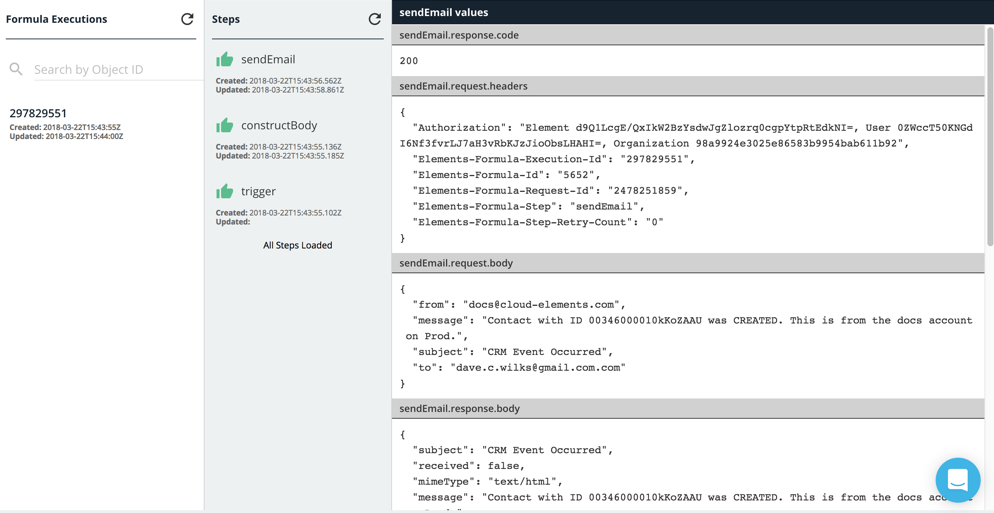
To review executions:
- On the Formulas page, hover over the formula card, and then click Open.
- Click Executions.
- Click the execution to review.
- Click the step to review.
To replay executions:
- On the Formulas page, hover over the formula card, and then click Open.
- Enable debugging by clicking the Debugging toggle.
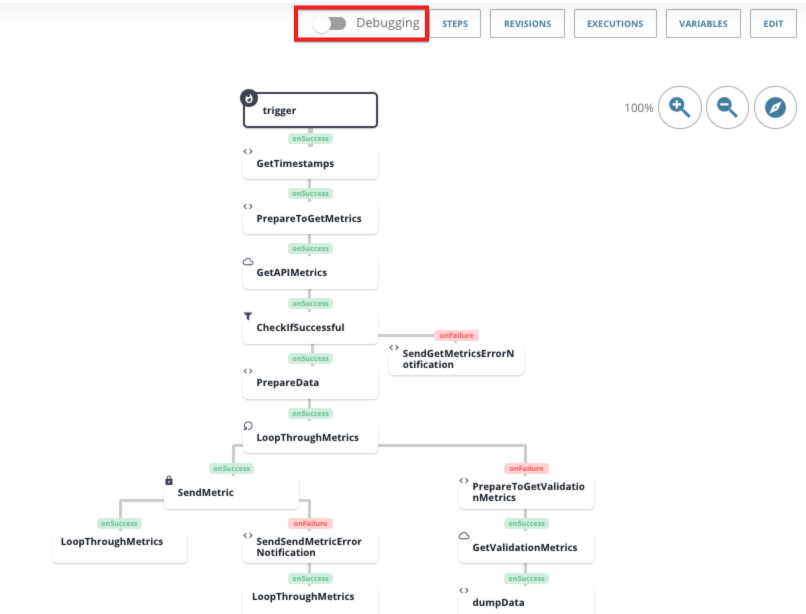
- Click Select Instance.

- Either select an existing formula instance by clicking its corresponding plus sign button, or click the Create Formula Instance button to create a new instance and define its variables.
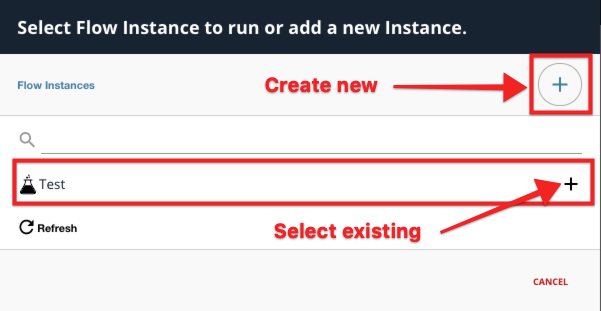
- After selecting an instance, click Run.
 As the execution runs, you can click individual steps in order to see the step's execution value.
As the execution runs, you can click individual steps in order to see the step's execution value.
Copy a Formula Template
You can build a formula template based on an existing template or from a SAP Open Connectors sample formula, resulting in a copy of the template.
To build a copy of a formula template:
- Click Formulas, and then on the Formulas page, click Build New Formula.

- Click Build From Existing Formula.
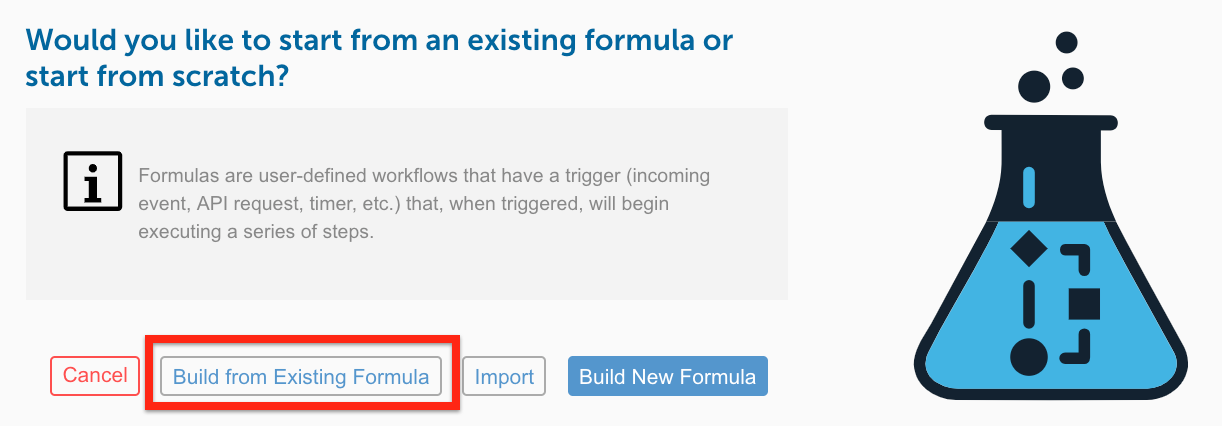
- To use one of your existing formula templates, select the template.
- To use a SAP Open Connectors formula template, click CE Sample Formulas, and then select the formula.
- Enter a name for your formula, and then click Create.
Import and Export Formula Templates
You can export a formula template as a JSON file and import other templates from their JSON source file.
To import a formula template:
- Click Formulas, and then on the Formulas page, click Build New Formula.

- Click Import.

- Select the JSON file to import.
- Optionally rename the file, and then click Create.
To export a formula:
- Navigate to the Formulas page.
- Hover over the connector card, and then click Export.
- Save the file.
Parallel Executions
To help formula instances execute as efficiently as possible, they take advantage of multithreaded executions. That is, multiple executions of the same formula instance can make requests at the same time. Some API providers prevent multiple requests from the same account at the same time. If this happens, you can change a formula template or an individual formula instance to execute one step at a time. This makes the formula less efficient and results in an increase in the execution time.
To change a formula from the default multithreaded execution to single threaded:
- Open the formula template. On the Formulas page, hover over the formula card, and then click Open.
- Click Edit.
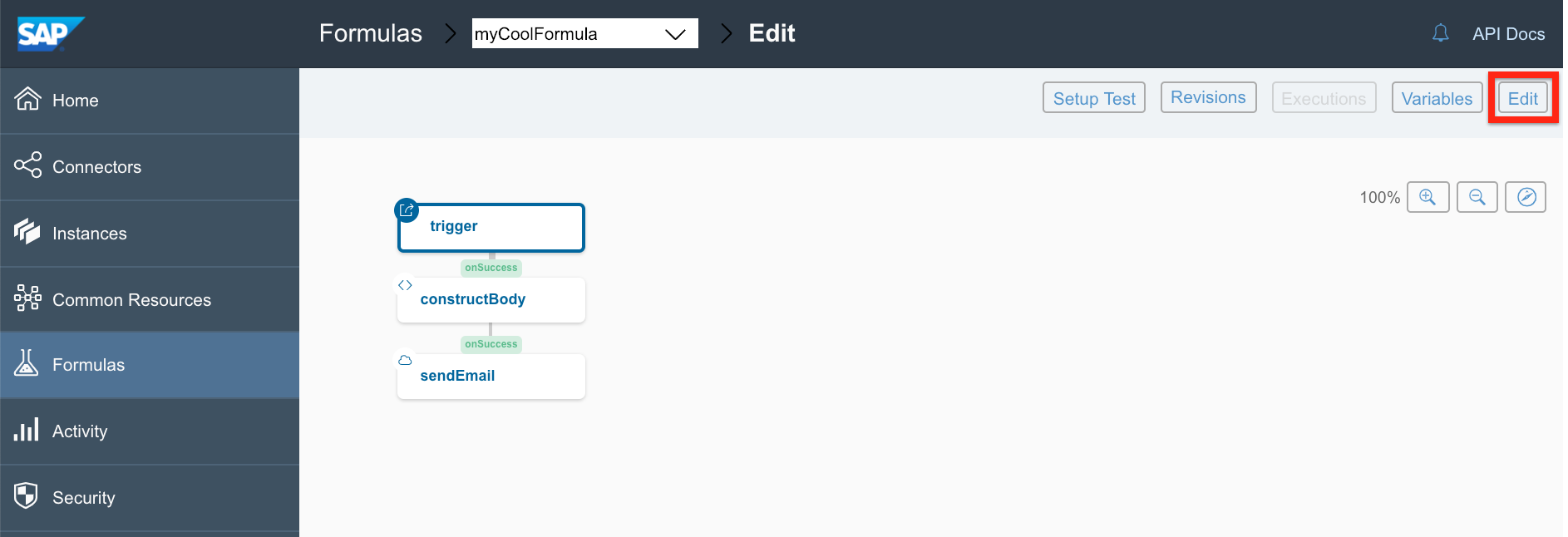
- Click Show Advanced.
- Switch Single Threaded Execution on.
- Click Save.
Alternatively, in the formula template or formula instance JSON, update singleThreaded to true:
{
"singleThreaded": true
}Rename a Formula Template
To rename a formula template:
- Open the formula template. On the Formulas page, hover over the formula card, and then click Open.
- Click Edit.

- Rename the formula template.
- Click Save.
Add a Description to a Formula Template
Descriptions provide more information about a formula template. Use the information to describe the formula template use case and anything another user might need when creating a formula instance. See Formula Readmes and Descriptions for additional information.
To add a description to a formula template:
- Open the formula template and click the space beneath Formula Description.
- Add your formula description and click Save.
Delete a Formula Template
You can delete a formula template if the template has no instances associated with it. If the formula template includes instances, delete those first.
To delete a formula template:
- Navigate to the Formulas page.
- Hover over the Formula Template card, and then click Delete.
- Confirm the deletion.
Deactivate a Formula Template
You can deactivate a formula template to prevent any executions of formula instances of the template.
To deactivate a formula:
- Open the formula template. From the Formulas page, hover over the formula template card, and then click Open.
- Click Edit.

- Switch the Active slider off.

- Click Save.
Access Formula Information
Each formula template and formula instance exposes information about itself through the info object.
{
"info":{
"formulaId":"123",
"formulaName":"name",
"formulaInstanceId":"123",
"formulaInstanceName":"name",
"formulaExecutionId":"1234"
}
}Formula information contributes to the formula context. You can access the information with info.property, such as info.formulaInstanceId or info.formulaName.
 .
.



 As the execution runs, you can click individual steps in order to see the step's execution value.
As the execution runs, you can click individual steps in order to see the step's execution value.
